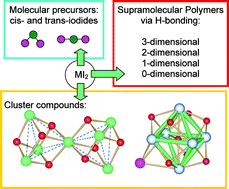This overview on one of the subjects treated in our group deals with the synthesis and study of low-dimensional polymer and molecular solid state structures formed with alkaline earth metal ions in non-aqueous solvents. We have chosen several synthetic approaches in order to obtain such compounds. The first concept deals with the “cutting out” of structural fragments from a solid state structure of a binary compound, which will be explained with reference to BaI2. Depending on the size and concentration of oxygen donor ligands, used as chemical scissors on BaI2, three-, two-, one- and zero-dimensional derived adducts of BaI2 are obtained, comparable to a structural genealogy tree for BaI2. A second part deals with the supramolecular approach for the synthesis of low dimensional polymeric compounds based on alkaline earth metal iodides, obtained by the combination of metal ion coordination with hydrogen bonding between the cationic complexes and their anions. Certain circumstances allow rules to be established for the prediction of the dimensionality of a given compound, contributing to the fundamental problem of structure prediction in crystal engineering. A third section describes a synthetic approach for generating pure alkaline earth metal cage compounds as well as alkali and alkaline earth mixed metal clusters. A first step deals with different molecular solvated alkaline earth metal iodides which are investigated as a function of the ligand size in non-aqueous solvents. These are then reacted with some alkali metal compound in order to partially or totally eliminate alkali iodide and to form the targeted clusters. These unique structures of ligand stabilized metal halide, hydroxide and/or alkoxide and aryloxide aggregates are of interest as potential precursors for oxide materials and as catalysts. Approaches to two synthetic methods of the latter, sol–gel and (MO)CVD (metal–organic chemical vapour deposition), are investigated with some of our compounds. (D. C. Bradley, Chem. Rev., 1989, 89, 1317–22; K. G. Caulton and L. G. Hubert-Pfalzgraf, Chem. Rev., 1990, 90, 969–95; T. P. Hanusa, Coord. Chem. Rev., 2000, 210, 329–367; T. P. Hanusa, in Comprehensive Coordination Chemistry II, ed. J. A. McCleverty and T. J. Meyer, Elsevier, Amsterdam, 2004, vol. 3, 1–92). Finally, the physical properties of some of our compounds are described qualitatively in order to show the wide spectrum of possibilities and potential applications for chemistry in this field.


 Please wait while we load your content...
Please wait while we load your content...